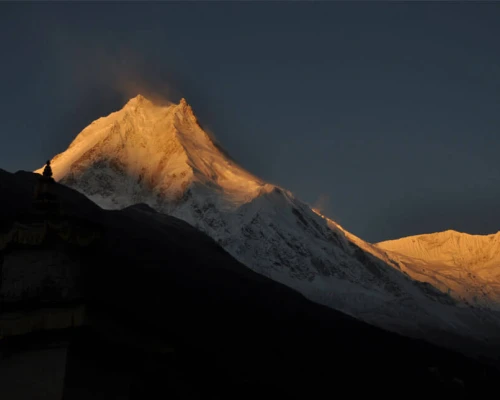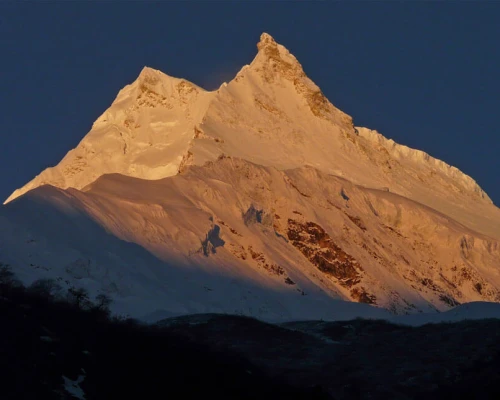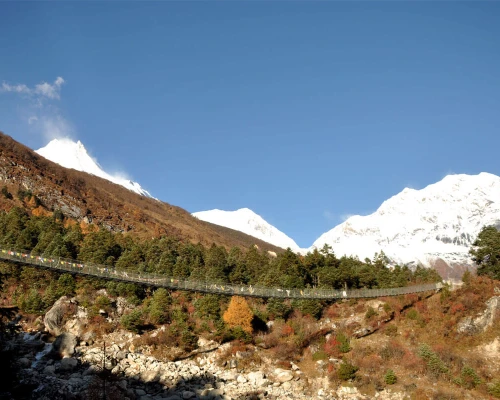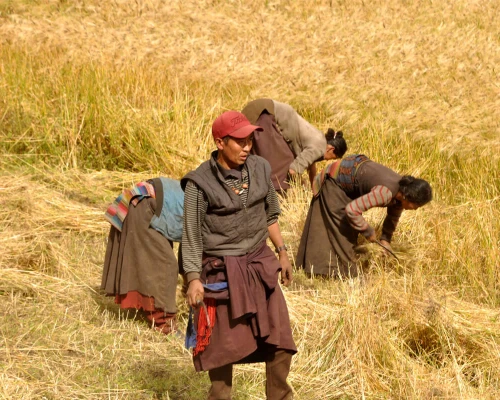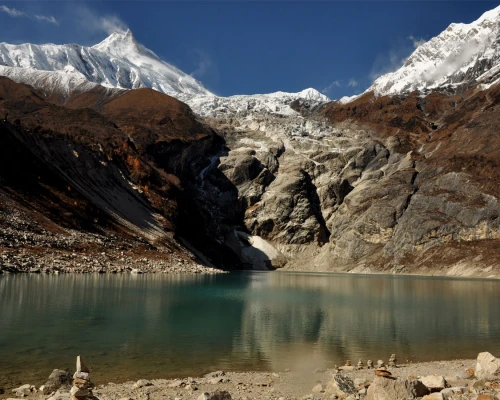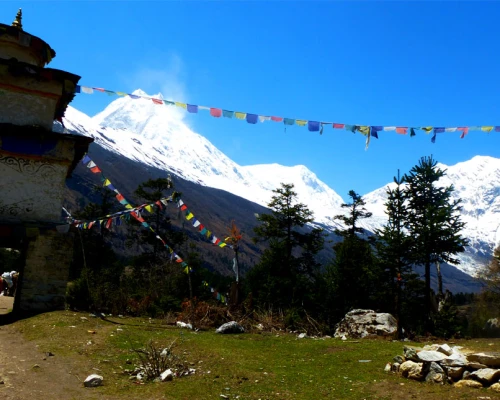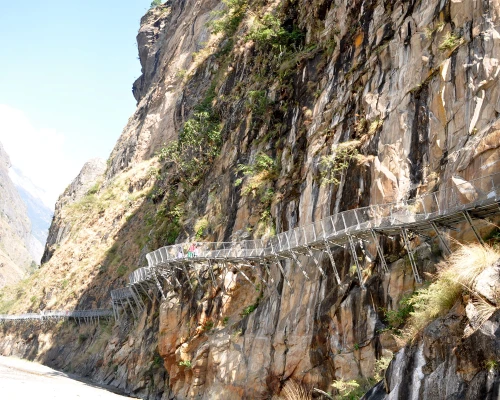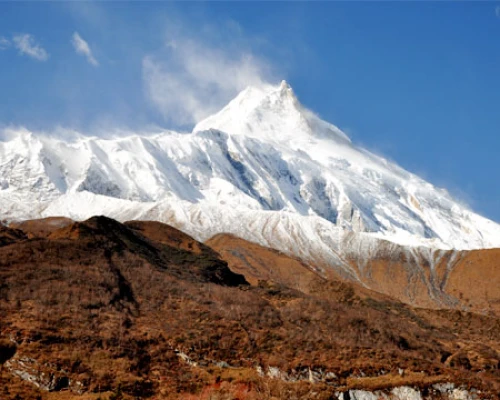- Trek to the heartland of Manaslu and soak in the grandeur of Mr. Manaslu, its base camp, and Larke La Pass. Enjoy spectacular views of Himlung Himal, Cheo Himal, Mt. Manaslu, Annapurna II, Peak 29, Lamjung Himal, Siringi, Simnang, Kang Guru, and more.
- Traverse through beautiful villages, valleys, suspension bridges, Birendra Lake, and Pungen Gompa, with an intimate look into Nepali-Tibetan culture and lifestyle.
- Discover Birch, juniper, and rhododendron forests accompanying the trekking trail with an opportunity to spot Himalayan flora and fauna - colorful birds, white-faced monkeys, Himalayan yaks, tahrs, and more.
On the Manaslu Circuit Trek, you will trek to Manaslu Base Camp and go even higher to Larke Pass with its glaciers and moraines. Of course, the magnificent views of Mt. Manaslu and other infamous peaks always accompany the rugged trail.
On this trek, you will hike through valleys, cross river bridges, and pass Mani walls and Chhortens. Additionally, you will leave footprints on one of the most challenging trekking routes in the world.
While less widely known than its counterpart - the Everest Base Camp Trek, this trekking trail is equally rewarding. On top of it, this trek arguably gives you a better look into the rural Nepali lifestyle and culture via landmarks like Pungen Gompa. Meanwhile, Birendra Lake in the Manaslu Glacier offers solace with its pristine turquoise water surrounded by snow-capped peaks, lush meadows, and colorful alpine flowers.
But for the most part, the challenge is what attracts trekkers from all over the world to the Manaslu region. If you’re one of them - adventurous and limitless - you will love the Manaslu Circuit Trek.

Manaslu Circuit: Remote and Off-the-Beaten-Path Trekking in Nepal
Arguably one of the most underrated treks, Manaslu Circuit is an epic Himalayan adventure on a lesser-known trail. This classic trek is a timeless journey through remote mountain villages, glacial moraines, hidden valleys, and Larke Pass.
Although more demanding than most of its equals, the trek to Manaslu Circuit is indeed imposing, offering a raw trekking experience. The route from lush lowlands to the Upper Himalayas passing the Budhi Gandaki River is rigorous but also tranquil with spectacular views.
It provides you with breathtaking glimpses of awe-inspiring landscapes and soaring snow peaks. Because of its remoteness, the trek allows you to delve deeper into nature amidst the high mountains.
While the trail offers a quieter atmosphere with a less crowded experience, it also poses significant challenges for many trekkers. Its rugged terrains with a mix of steep ascents and descents, rocky moraines, and snow slopes demand excellent physical prowess.
Unlike most commercial treks, the Manaslu Circuit requires trekkers to navigate off-the-beaten trails, after a bumpy ride to Soti Khola. Subsequently, they have to make a strenuous journey through narrow cliffs and remote wilderness.
Further along, the trail weaves the wooded forests, crosses suspension bridges, and passes several rural settlements. Larke Pass is the highest point trekkers can reach in the Manaslu region without a climbing permit.
Enriching Cultural and Spiritual Recess at Pungen Gompa
Manaslu’s scenic splendor and cultural richness are so intricately connected that one rarely escapes attention. Visitors embarking on its classic trail are intrigued by the profound Tibetan history and enriching customs woven throughout the journey.
Starting from Jagat, a vibrant Gurung village perched on the slopes of the Himalayas, trekkers are overwhelmed by the fascinating culture and religious retreat. One of many spiritual sanctuaries, known for its cultural essence is Pungen Gompa.
Nestled right beneath the shoulder of Manaslu, Pungen Monastery is a spiritual hub where monks engage in sacred practices and religious ceremonies. It’s where the Tibetan believes the Goddess of Pungen resides.
Although the origination of Pungen Gompa remains obscure, its prominence is linked with the spread of Buddhism. When the Tibetan masters traversed the mountainous terrain, monasteries like Pungen became a center for teaching Buddhism and meditation.
It’s their descendants and local indigenous people Nubri who later built the holy shrine to please lord Pungen. Today, Pungen Gompa looms large as a cultural treasure trove where Buddhist traditions thrive.
It also stands as a prominent place for visitors and locals, who are in quest of cultural enrichment and spiritual enlightenment. The monastery is a center for learning Tibetan Buddhism and engaging in meditation and religious practice.
At times, it bursts into the scene with vibrant celebrations of traditional rituals and festivals. The harmonious chants of monks fill the air as they recite mantras during evening prayers. It also comes alive during festivals like Lhoshar, when locals and visitors gather for traditional music performances and mask dances.
Mountain Peaks Visible During the Trek to Manaslu Base Camp
It’s safe to say that Larke La Pass draws the most attention in the Manaslu region but the appeal Manaslu Base Camp holds is second to none. Nothing compares to its idyllic charm, rugged scenery, and marvelous views, which evoke joy.
Regardless, the thing that truly sets Manaslu Base Camp apart is its unique formation, which rewards trekkers with a most up-close view of Manaslu ranges. Its distinctive layout enhances the trekking experience and allows trekkers to enjoy the grandeur fully.
Standing at an apex, you can get a frontal view of the north face of Mt. Manaslu along with Shringi, Ngadi, and Ganesh Himal. From the distance to the west, you’re in awe of the grandeur of Mt. Annapurna.
Other mountains that encompass Manaslu Base Camp and offer panoramic views include Himalchuli, Baudha, Gyaji Kung, and Pawar Peak. The pristine view of Kang Guru to the northwest of Mansiri Himal also adds to the marvelous scenery of the Manaslu region.
Another snow-clad peak that provides a scenic backdrop from the standpoint of Manaslu Base Camp is Himlung Pyramid. You can catch a glimpse of its distinct Pyramid-shaped structure soaring high above the clouds from the camp, which looks both formidable and stunning.
Birendra Lake and Manaslu Glacier: Serenity and Splendor in Manaslu Trek
With several lakes scattered along the trail of Manaslu Circuit, chances are that you might come across a few. But it’s unlikely for all of them to be cradled by the Himalayas or witness the reflection of mighty Manaslu as Birendra Tal.
Spanned across 3 sq. km, Birendra Tal stands out as nature’s work of art with tranquil settings and rustic charm. Encircled by giant mountains, this hidden gem was named after Late King Birendra.
While there’s no true account of how Birendra Lake came into formation, its existence is tightly bound to the Manaslu ranges. The lake feeds on the melting glaciers of Manaslu, whose reflective blue color and quiet presence captivate visitors seeking solace.
Over time, Birendra Lake has been a spiritual haven for both visitors and locals. While many trekkers choose the lake as a stopover on their journey to Manaslu Base camp, others prefer a solo escapade, involving 2.5 hours hike south of Samagaun.
Either way, the lake offers them a tranquil atmosphere, where they can bask in the beauty of nature. Sitting on the shore of the lake, visitors can enjoy the serenity and the magnificent view of Manaslu Glacier and Annapurna I.
Manaslu Circuit Trek Cost for 2026 and 2027 Bookings
The Manaslu Circuit Trek cost starts from 900 USD per person for a 13-day all-inclusive itinerary.
Different trekking agencies offer different booking costs for the Manaslu circuit trek. With the given price, we have included all the necessary things that you'll have to pay for the trek. We included your permit, land transport to the trekking starting point and return, your meals, accommodation, guide, and porter.
For Manaslu Circuit Trek reservations, scheduled dates are displayed on this page on a group joining basis, and if you are more than two in a group, then we can also organize a private trek at the same cost.


